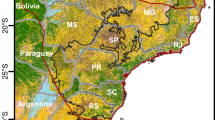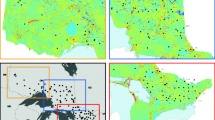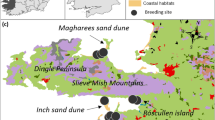Abstract
Landscape connectivity can have profound consequences for distribution and persistence of populations and metapopulations. Evaluating functional connectivity of a landscape for a species requires a measure of dispersal rates through landscape elements at a spatial scale sufficient to encompass movement capabilities of individuals over the entire landscape. We evaluated functional connectivity for a rock-dwelling mammal, the mountain vizcacha (Lagidium viscacia), in northern Patagonia. Because of the strict association of mountain vizcachas with rocks, we hypothesized that connectivity for this species would be influenced by geology. We used molecular genetic estimates of gene flow to test spatially explicit models of connectivity created with GIS cost-distance analysis of landscape resistance to movement. We analyzed the spatial arrangement of cliffs with join counts and local k-function analyses. We did not capture and genotype individuals, but sampled at the population level through non-invasive collection of feces of mountain vizcachas. The model of landscape connectivity for mountain vizcachas based on geology was corroborated by the pattern of genetic structure, supporting the hypothesis that functional connectivity for mountain vizcachas is influenced by geology, particularly by the distribution of appropriate volcanic rocks. Analysis of spatial arrangement of cliffs indicated that occupied cliffs are clustered and confirmed that rivers act as barriers to dispersal for mountain vizcachas. Our methods could be used, within certain constraints, to study functional landscape connectivity in other organisms, and may be particularly useful for cryptic or endangered species, or those that are difficult or expensive to capture.




Similar content being viewed by others
References
Adriaensen F, Chardon JP, De Blust G, Swinnen E, Villalba S, Gulinck H, Matthysen E (2003) The application of “least-cost” modelling as a functional landscape model. Landsc Urban Plan 64:233–247
Bélisle M (2005) Measuring landscape connectivity: the challenge of behavioural landscape ecology. Ecology 86:1988–1995
Broquet T, Petit E (2004) Quantifying genotyping errors in noninvasive population genetics. Mol Ecol 13:3601–3608
Broquet T, Ray N, Petit E, Fryxell JM, Burel F (2006) Genetic isolation by distance and landscape connectivity in the American marten (Martes americana). Landsc Ecol 21:877–889
Chen DM, Getis A (1998) Point pattern analysis. Online program URL: http://www.nku.edu/∼longa/cgi-bin/cgi-tcl-examples/generic/ppa/ppa.cgi
Cliff AD, Ord JK (1973) Spatial autocorrelation. Pion Ltd, London
Coulon A, Cosson JF, Angibault JM, Cargnelutti B, Galan M, Morellet N, Petit E, Aulagnier S, Hewison JM (2004) Landscape connectivity influences gene flow in a roe deer population inhabiting a fragmented landscape: an individual-based approach. Mol Ecol 13:2841–2850
D’Eon RG, Glenn SM, Parfitt I, Fortin M-J (2002) Landscape connectivity as a function of scale and organism vagility in a real forested landscape. Cons Ecol 6:10 [online] URL: http://www.consecol.org/vol6/iss2/art10
Eastman JR (1989) Pushbroom algorithms for calculating distances in raster grids. Autocarto 9:288–297
Ernest HB, Penedo MCT, May BP, Syvanen M, Boyce WM (2000) Molecular tracking of mountain lions in the Yosemite Valley region in California: genetic analysis using microsatellites and faecal DNA. Mol Ecol 9:433–441
Ferreras P (2001) Landscape structure and asymmetrical inter-patch connectivity in a metapopulation of the endangered Iberian lynx. Biol Cons 100:125–136
Flagstad Ø, Røed K, Stacy JE, Jakobsen KS (1999) Reliable noninvasive genotyping based on excremental PCR of nuclear DNA purified with a magnetic bead protocol. Mol Ecol 8:879–883
Gaggiotti O, Lange EO, Rassman K, Gliddon C (1999) A comparison of two indirect methods for estimating average levels of gene flow using microsatellite data. Mol Ecol 8:1513–1520
Getis A, Franklin J (1987) Second-order neighborhood analysis of mapped point patterns. Ecology 68:473–477
Goodman S (1997) RST calc: a collection of computer programs for calculating estimates of genetic differentiation from microsatellite data and determining their significance. Mol Ecol 6:881–885
Goudet J (2000) FSTAT, a program to estimate and test gene diversities and fixation indices (version 2.9.1). Available from http://www.unil.ch/izea/softwares/fstat.html
Graham CH (2001) Factors influencing movement patterns of keel-billed toucans in a fragmented tropical landscape in southern Mexico. Cons Biol 15:1789–1798
Hartl DL, Clark AG (1997) Principles of population genetics, 3rd edn. Sinauer Assoc., Inc., Sunderland
Hoeck HN (1982) Population dynamics, dispersal and genetic isolation in two species of hyrax (Heterohyrax brucei and Procavia johnstoni) on habitat islands in the Serengeti. Z Tierpsychol 59:177–210
Jonsen ID, Bourchier RS, Roland J (2001) The influence of matrix habitat on Aphthona flea beetle immigration to leafy spurge patches. Oecologia 127:287–294
Keyghobadi N, Roland J, Strobeck C (1999) Influence of landscape on the population genetic structure of the alpine butterfly Parnassus smintheus (Papilionidae). Mol Ecol 8:1481–1495
Knaapen JP, Scheffer M, Harms B (1992) Estimating habitat isolation in landscape planning. Landsc Urban Plan 23:1–16
León RJC, Bran D, Collantes M, Paruelo JM, Soriano A (1998) Grandes unidades de vegetación de la Patagonia extra andina. Ecol Aust 8:125–144
Manel S, Schwartz MK, Luikart G, Taberlet P (2003) Landscape genetics: combining landscape ecology and population genetics. Trends Ecol Evol 18:189–19
Mantel N (1967) The detection of disease clustering and a generalized regression approach. Cancer Res 27:209–220
Mares MA, Lacher TE (1987) Ecological, morphological, and behavioral convergence in rock-dwelling mammals. In: Genoways H (ed) Current mammalogy, vol 1. Plenum Press, New York, pp 307–348
Merriam G (1995) Movement in spatially divided populations: responses to landscape structure. In: Lidicker WZ (ed) Landscape approaches in mammalian ecology and conservation. University of Minnesota Press, Minneapolis, pp 64–77
Michels E, Cottenie K, Neys L, De Gelas K, Coppin P, De Meester L (2001) Geographical and genetic distances among zooplankton populations in a set on interconnected ponds: a plea for using GIS modeling of the effective geographical distance. Mol Ecol 10:1929–1938
Miller M (1997) Tools for population genetic analysis (TFPGA), Version 1.3. A Windows program for analysis of allozyme and molecular population genetic data. Software distributed by the author
Moilanen A, Niemenin M (2002) Simple connectivity measures in spatial ecology. Ecology 83:1131–1145
Pither J, Taylor PD (1998) An experimental assessment of landscape connectivity. Oikos 83:166–174
Pope LC, Sharp A, Moritz C (1996) Population structure of the yellow-footed rock-wallaby Petrogale xanthopus (Gray, 1854) inferred from mtDNA sequences and microsatellite loci. Mol Ecol 5:629–640
Raymond M, Rousset F (1995a) GENEPOP (version 1.2): population genetics software for exact tests and ecumenicism. J Hered 86:248–249
Raymond M, Rousset F (1995b) An exact test for population differentiation. Evolution 49:1280–1283
Rice WR (1989) Analysing tables of statistical tests. Evolution 43:223–225
Roland J, Keyghobadi N, Fownes S (2000) Alpine Parnassius butterfly dispersal: effects of landscape and population size. Ecology 81:1642–1653
Rosenberg MS (2001) PASSAGE: pattern analysis, spatial statistics, and geographic exegesis. Version 1.1, Release 3.4. Department of Biology, Arizona State University, Tempe
Rousset F (1997) Genetic differentiation and estimation of gene flow from F-statistics under isolation by distance. Genetics 145:1219–1228
Slatkin M (1995) A measure of population subdivision based on microsatellite allele frequencies. Genetics 139:457–462
Sutcliffe OL, Bakkestuen V, Fry G, Stabbetorp OE (2003) Modelling the benefits of farmland restoration: methodology and application to butterfly movement. Landsc Urban Plan 63:15–31
Taberlet P, Waits LP, Luikart G (1999) Noninvasive genetic sampling: look before you leap. Trends Ecol Evol 14:323–327
Taylor PD, Fahrig L, Henein K, Merriam G (1993) Connectivity is a vital element of landscape structure. Oikos 68:571–573
Tischendorf L, Fahrig L (2000) On the usage and measurement of landscape connectivity. Oikos 90:7–19
Verbeylen G, De Bruyn L, Adriaensen F, Matthysen E (2003) Does matrix resistance influence Red squirrel (Sciurus vulgaris L. 1758) distribution in an urban landscape? Landscape Ecol 18:791–805
Vignieri SN (2005) Streams over mountains: influence of riparian connectivity on gene flow in the Pacific jumping mouse (Zapus trinotatus). Mol Ecol 14:1925–1937
Vos CC, Antonisse-de Jong AG, Goedhart PW, Smulders MJM (2001) Genetic similarity as a measure for connectivity between fragmented populations of the moor frog (Rana arvalis). Heredity 86:598–608
Walker RS, Farmerie WG, Branch LC (2000a) Characterization of microsatellite loci for the mountain vizcacha Lagidium viscacia and their use in the plains vizcacha Lagostomus maximus. Mol Ecol 9:1672–1674
Walker RS, Ackermann G, Schachter-Broide J, Pancotto V, Novaro AJ (2000b) Habitat use by mountain vizcachas (Lagidium viscacia Molina, 1782) in the Patagonian steppe. Z Säugetierkd 65:293–300
Walker RS, Novaro AJ, Branch LC (2003) The effects of patch attributes, barriers, and distance between patches on the distribution of a rock-dwelling rodent (Lagidium viscacia). Landsc Ecol 18:185–192
Weir BS, Cockerham CC (1984) Estimating F-statistics for the analysis of population structure. Evolution 38:1358–1370
Acknowledgments
We thank the Centro de Ecología Aplicada del Neuquén for logistical support in the field. We thank J. Ayesa and the Lab de Teledetección de INTA-Bariloche for the digitized geological map, and O. Monsalvo, J. Schachter-Broide, V. Pancotto, G. Ackerman, and M. Biongiorno for assistance in the field. We thank landowners and the Delegación Regional Patagonia de Administración de Parques Nacionales de Argentina for permission to carry out the study. Funding was provided by the Lincoln Park Zoo Scott Neotropic Fund, Sigma Xi, the American Society of Mammalogists, and National Science Foundation doctoral dissertation improvement grant number DEB-9972717. Additional support was provided by the Wildlife Conservation Society and the University of Florida. We especially thank A. Clark, B. Bowen, W. Farmerie, D. Moraga Amador, and D. Brazeau for guidance in the lab. Finally, we thank B. Bowen, G. Tanner, M. Sunquist, C. Chapman, and two anonymous reviewers for helpful comments on the manuscript.
Author information
Authors and Affiliations
Corresponding author
Rights and permissions
About this article
Cite this article
Walker, R.S., Novaro, A.J. & Branch, L.C. Functional connectivity defined through cost-distance and genetic analyses: a case study for the rock-dwelling mountain vizcacha (Lagidium viscacia) in Patagonia, Argentina. Landscape Ecol 22, 1303–1314 (2007). https://doi.org/10.1007/s10980-007-9118-2
Received:
Accepted:
Published:
Issue Date:
DOI: https://doi.org/10.1007/s10980-007-9118-2




